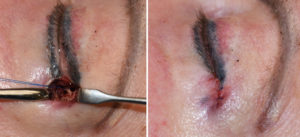The lateral canthoplasty is a well recognized eye corner procedure which is most commonly used in reconstructive lower eyelid surgery. It is used to treat a variety of lower eyelid problems which are fundamentally various forms of ectropion and retraction. The basic concept is to deconstruct the lateral canthal angle and re-anchor the lateral eyelid to the periosteum of the lateral orbital rim in a more superior position with the placement motto of ‘high and tight’ in many instances.
While often done through a lateral canthal skin incision , it can also be done through a upper eyelid incision which offers the advantage of a naturally higher vector for periosteal anchorage to ensure adequate superior relocation. Such an upper eyelid approach also avoids pulling the lower eyelid corner under the upper eyelid margin creating a lid overhang effect.
Many different suture fixation techniques have been advocated for the lateral canthoplasty procedure. They consist of two basic methods which rely on either a direct suture-periosteum fixation or bypassing the periosteum as a point of suture fixation and using the bone instead. The periosteum is bypassed by making drill holes in the lateral orbital rim for transosseous suture fixation. Such drill holes have been done either as a single or double hole techniques.

In lateral eye reshaping surgery the slope of the outer eye goes upward with varying amounts of elevation above that of the inner eye. In the properly selected patient who has adequate lower eyelid skin, no scleral show and a normal canthal location, the lateral canthoplasty is the most secure method to change the outer corner of the eye position in a reliable and secure fashion.
Dr. Barry Eppley
Indianapolis, Indiana


